New Year, New Hope? But 2017 began with Britain being hit with a vegetable shortage!
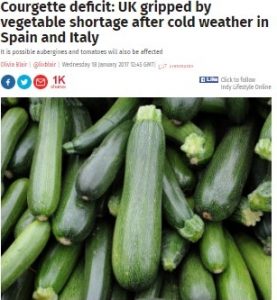
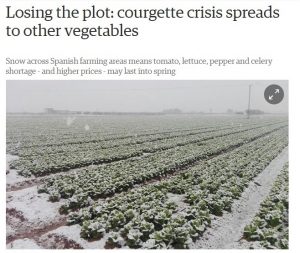
(Independent, 2017) (The Guardian, 2017)
But apart from halting our “clean eating” resolutions…..
Is a courgette shortage really the end of the world?
Well, probably not! But globally, food security is no laughing matter.
And what is the cause you may ask? Climate change, of course!
The evidence for climate change is overwhelming.
The Earth’s average temperature has increased by 0.85°C between 1980-2012 (IPCC, 2014). This may seem insignificant, yet, it has severe consequences, such as the ice caps melting, sea levels rising and increased occurrence of extreme weather events (Overpeck and Cole, 2006).
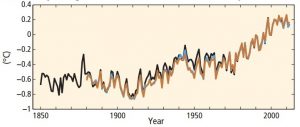
Globally averaged combined land and ocean surface temperature (IPCC, 2014)
Humans are to blame.
Since the industrial revolution, burning of fossil fuels has increased emissions of carbon dioxide (CO2) and other greenhouse gases (GHGs) These GHGs act as a blanket, trapping energy in the atmosphere, causing Earth’s temperature to rise (IPCC, 2014).
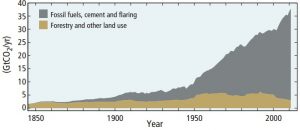
Global Human CO2 Emissions, IPCC, 2014
The good?
Higher CO2 levels increase plant photosynthesis (Pospisilova and Catsky, 1999). Photosynthesis depends on an enzyme called Rubisco, which evolved at higher prehistoric CO2 levels, therefore has higher activity when CO2 increases (Bowes, 1996). This increases plant growth, thereby increasing crop yield, in a phenomenon termed “CO2-fertlisation” (Allen, 1990).
This is particularly pronounced plants categorised at C3 , which includes major crops such as rice, wheat and soybean. Increasing CO2 to 550pm causes 10-20% increase in C3 crop yield, but only 0-10% increase plants categorised as C4, which includes the crops maize and sorghum (Schmidhuber and Tubiello, 2007).
CO2 enters plants through stomata (plant pores), therefore, at higher CO2 levels the stomata need not open as often, termed reduced stomatal conductance. This decreases the amount of water lost through the pores in the process of transpiration, thereby increasing the water efficiency of the plants (Drake et al., 2007).
The bad?
So, is climate change good for plants if it causes increased growth and higher water efficiency? Well no, it was never going to be that simple…
Extreme weather events negatively impact food security, both directly by reduced yields from damaged crops but also indirectly by increasing the chance of landslides and soil erosion, thereby reducing the land available for agriculture (Cerri et al., 2007).
This issue is becoming more urgent as global population increases at an unprecedented rate, increasing the demand for food (MA, 2005).
Food security issues are not only concerned with the quantity of food but also the quality, as globally many people suffer from malnutrition (MA, 2005). Elevated CO2 decreases the zinc, iron, and protein content in wheat, barley, and rice (Myers et al., 2014).
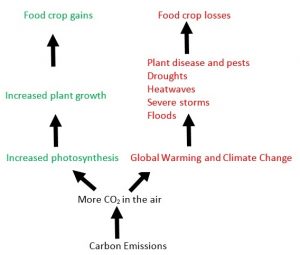
The two-fold effect of increased CO2 form increased carbon emissions; most likely the negative effect will outweigh the positive effect.
The ugly truth
Unfortunately, it is predicted the losses will outweigh any gains from CO2 fertilisation.
Ultimately, lack of food could see increased prices for consumers in the developed world whilst the developing world will suffer with food shortage and malnutrition.
Lack of courgettes may seem a trivial matter but is it just one more sign that we getting closer to the tipping point of our planet’s ability to cope with climate change.
Word count: 499
References
Allen, L.H. Jr. (1990). Plant responses to rising carbon dioxide and potential interactions with air pollutants. J. Environ. Qual, 19: 15-34.
Bowes G. (1996) Photosynthetic responses to changing atmospheric carbon dioxide. pp. 387-407. In: N.R. Baker (ed.). Photosynthesis and the Environment. Advances in Photosynthesis, Vol. 5, Kluwer, Dordrecht
Cerri, C. E.P., Sparovek, G., Bernoux, M., Easterling, W.E., Melillo, J. M., and Cerri C. C. (2007). Tropical Agriculture and Global Warming: Impacts and Mitigation Options. Sci. Agric., 64(1): 83-89.
Drake, B.G., Gonzàlez-Meler, M.A. and Long, S.P., 1997. More efficient plants: a consequence of rising atmospheric CO2? Annual review of plant biology, 48(1): 609-639.
IPCC. (2014) Climate Change 2014: Synthesis Report. Contribution of Working Groups I, II and III to the Fifth Assessment Report of the Intergovernmental Panel on Climate Change. R.K. Pachauri and L.A. Meyer (eds.). IPCC, Geneva, Switzerland, pp. 151.
Millennium Ecosystem Assessment (2005). Ecosystems and Human Well-being: Synthesis. Island Press, Washington, DC.
Myers SS, Zanobetti A, Kloog I, et al. (2014). Rising CO2 threatens human nutrition. Nature. 510(7503): 139-142.
Overpeck, J.T. and Cole, J.E. (2006). Abrupt change in Earth’s climate system. Annual Review of Environment and Resources, 31: 1-31.
Pospisilova, J. and Catsky, J. (1999). Development of water stress under increased atmospheric CO2 concentration. Biologia Plantarum, 42: 1-24.
Schmidhuber, J. and Tubiello, F.N. (2007). Global food security under climate change. Proc. Natl. Acad. Sci. USA, 104(50): 19703-8.
Recent Comments